Cấu trúc và tính chất của cluster VB₅⁻/⁰ tính bằng lý thuyết phiếm hàm mật độ
Lý thuyết phiếm hàm mật độ với phiếm hàm BPW91 và bộ hàm cơ sở def2-TZVP được sử dụng để nghiên
cứu cấu trúc hình học của cluster VB5−/0 . Bằng cách sử dụng thuật toán đàn ong nhân tạo, 300 cấu trúc ban
đầu được tạo ra cho cluster được nghiên cứu. Quá trình tối ưu hóa hình học bằng phiếm hàm BPW91 và bộ
hàm cơ sở def2-SVP cho thấy cluster anion có 18 đồng phân năng lượng thấp ở trạng thái quartet. Phiếm
hàm BPW91 và bộ hàm cơ sở def2-TZVP cũng tính được năng lượng tương đối và tần số dao động điều hòa
ứng với trạng thái spin khác nhau của 7 đồng phân của cluster anion và 6 đồng phân của cluster trung hòa.
Kết quả tính toán cho thấy rằng đồng phân bền nhất là A-VB5−/0 với cấu trúc ngũ giác không phẳng. Năng
lượng tách của cluster anion và năng lượng ion hóa của cluster trung hòa là 1,93 và 7,36 eV.
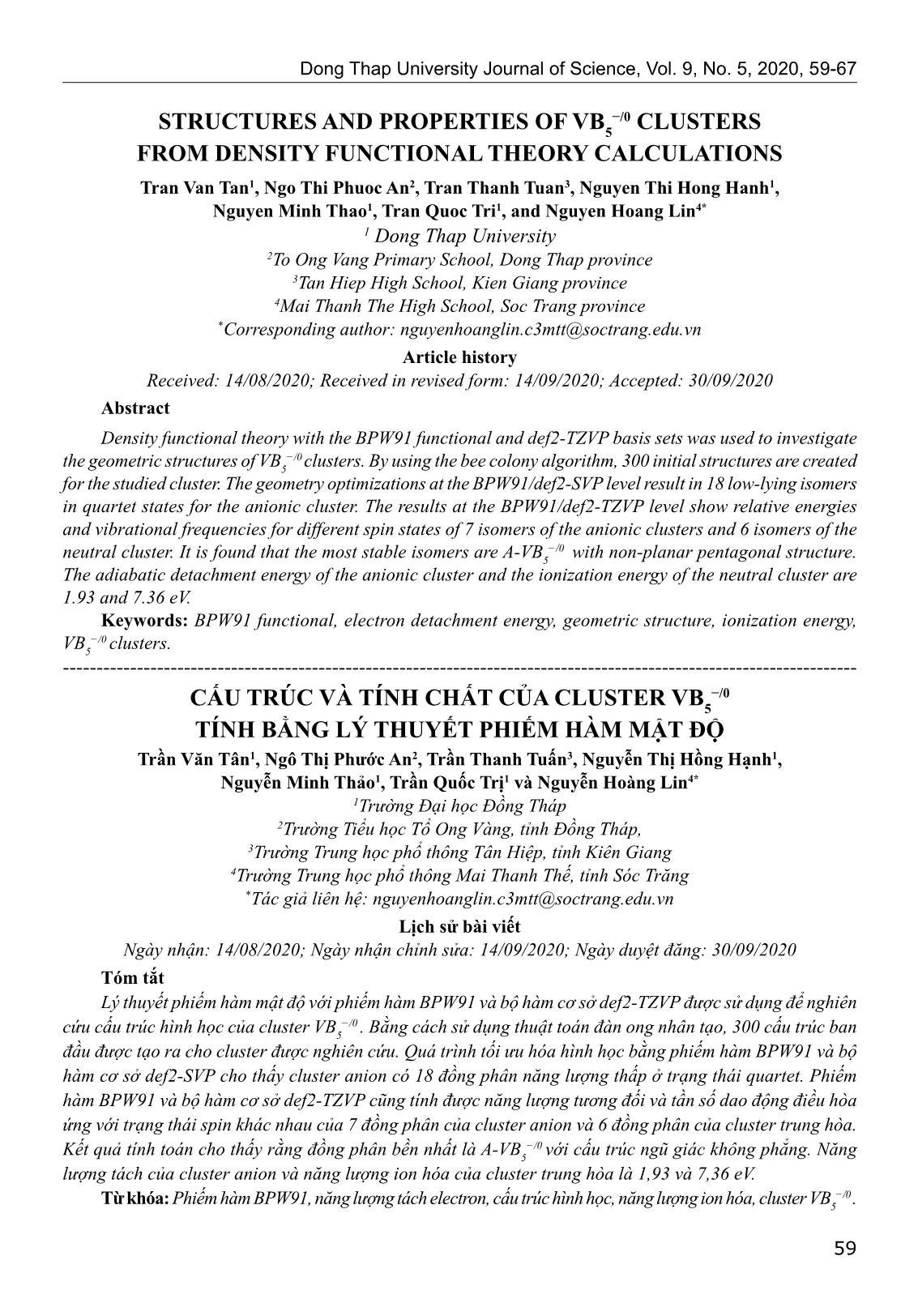
Trang 1
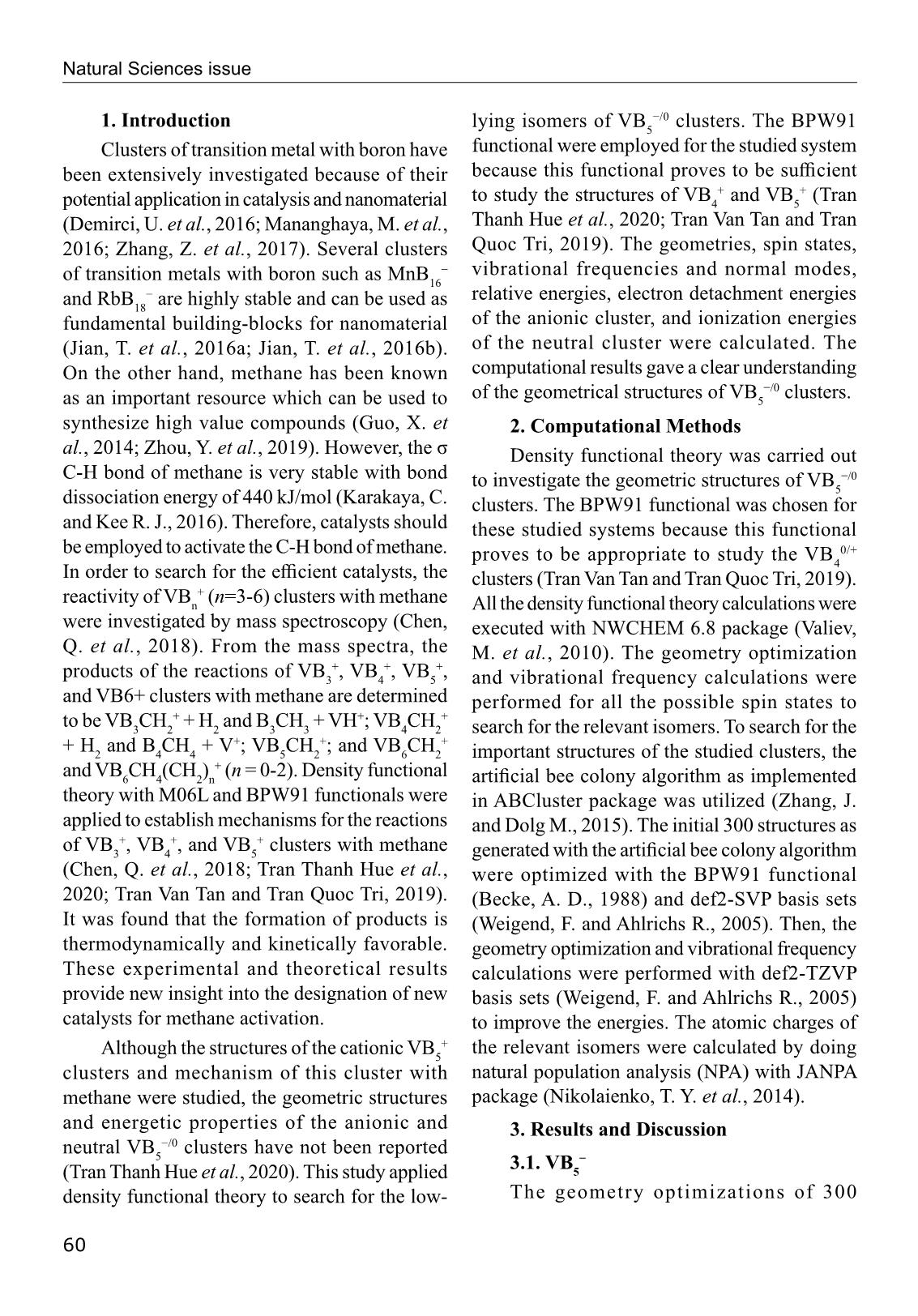
Trang 2
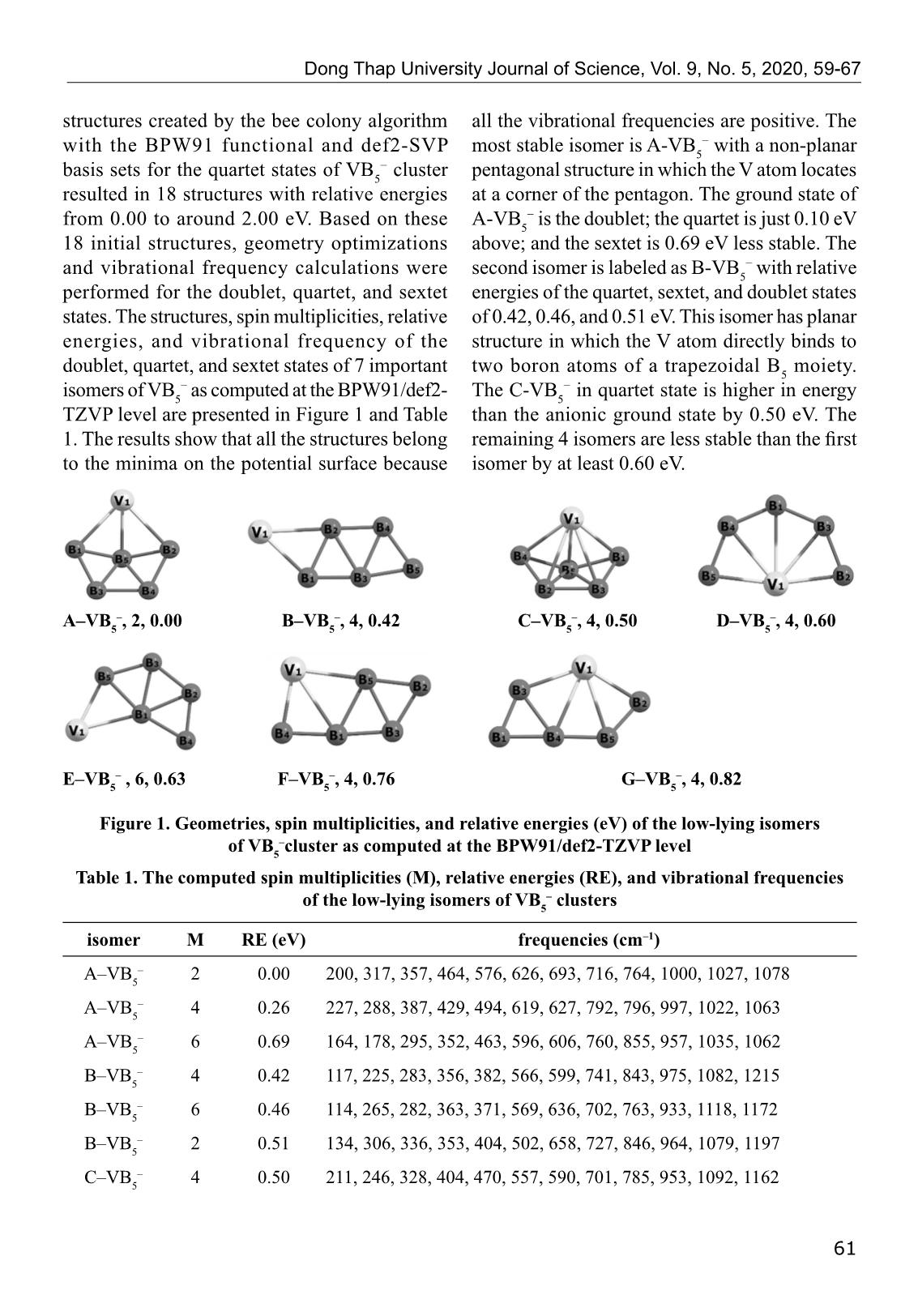
Trang 3
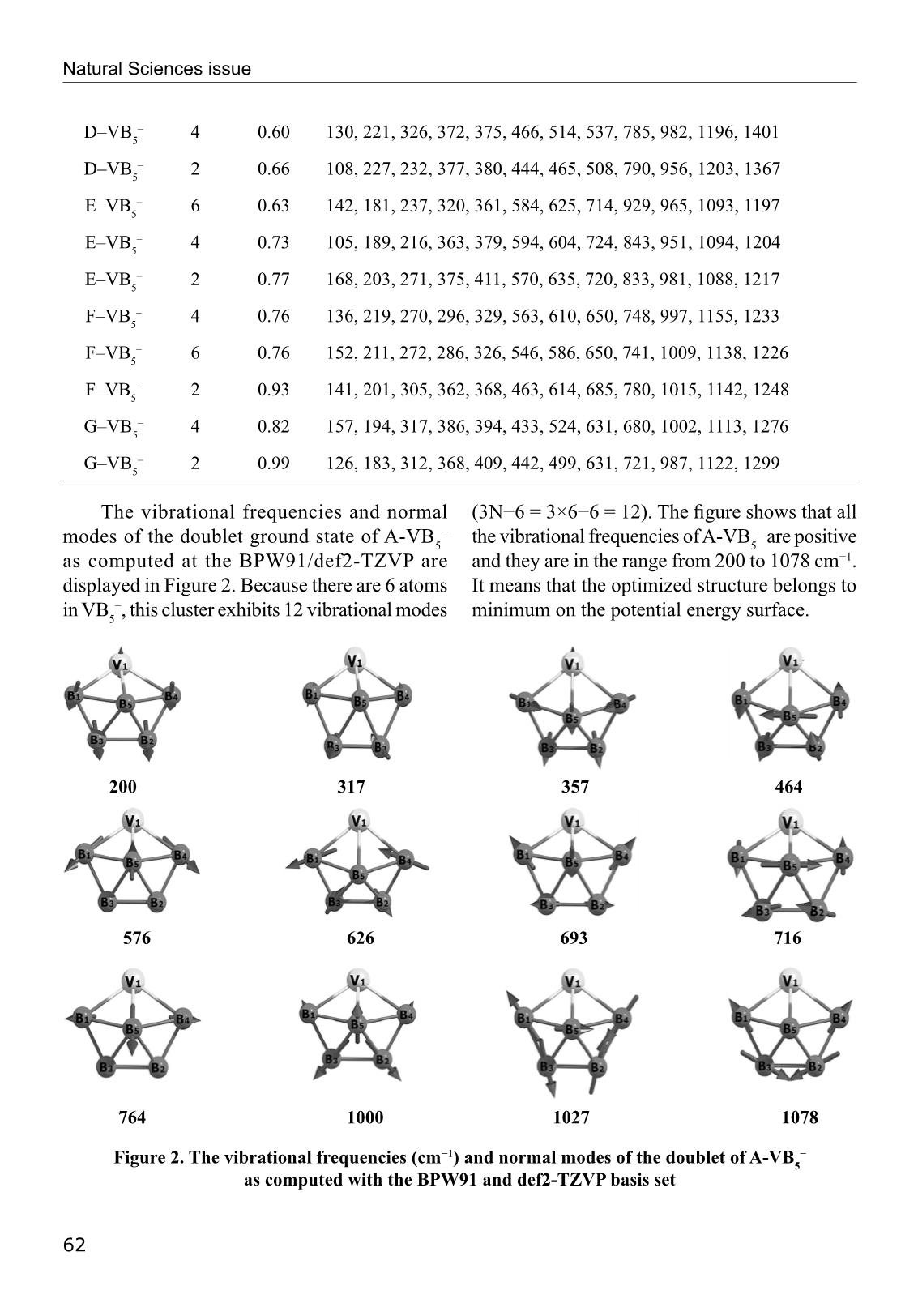
Trang 4
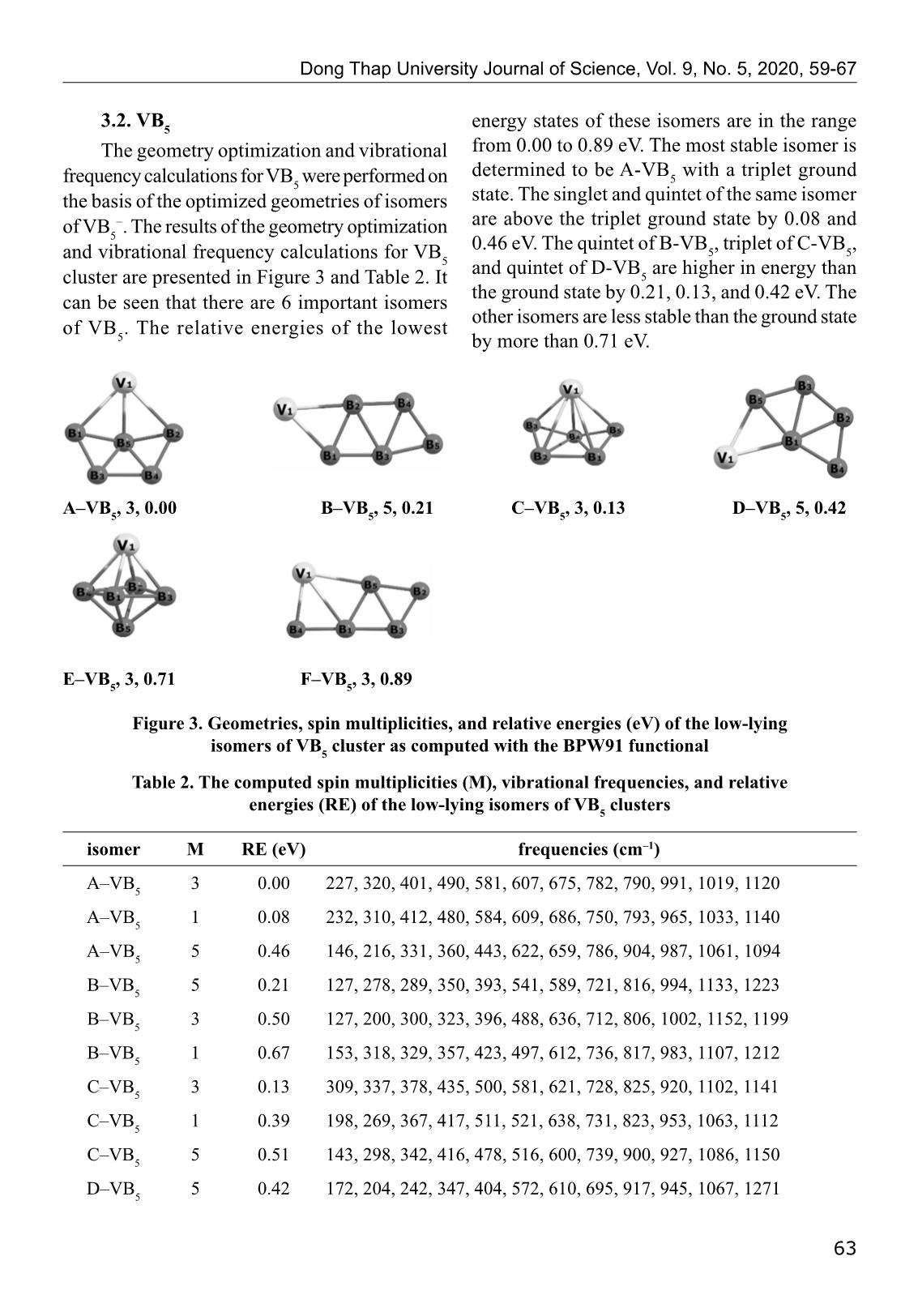
Trang 5
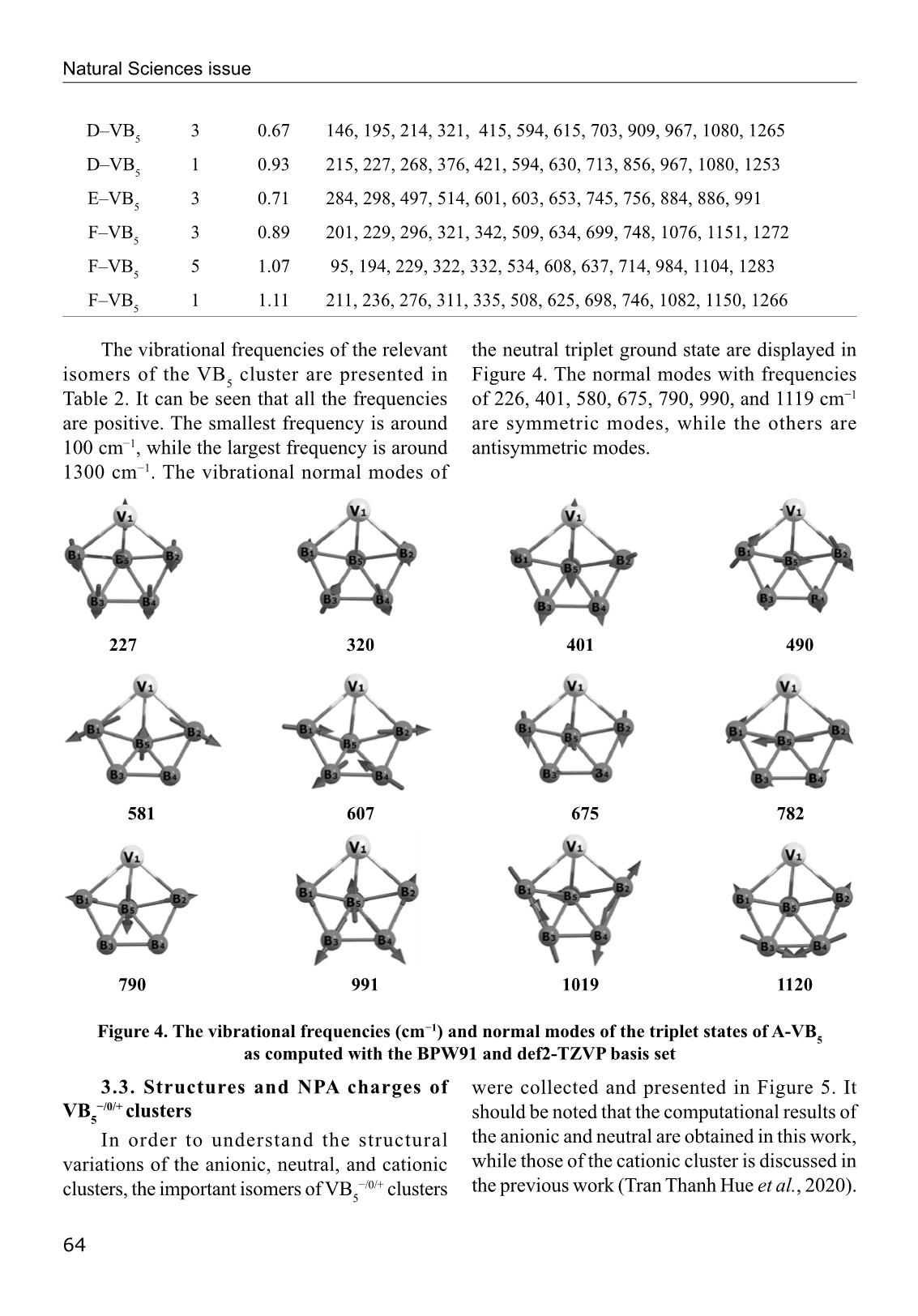
Trang 6
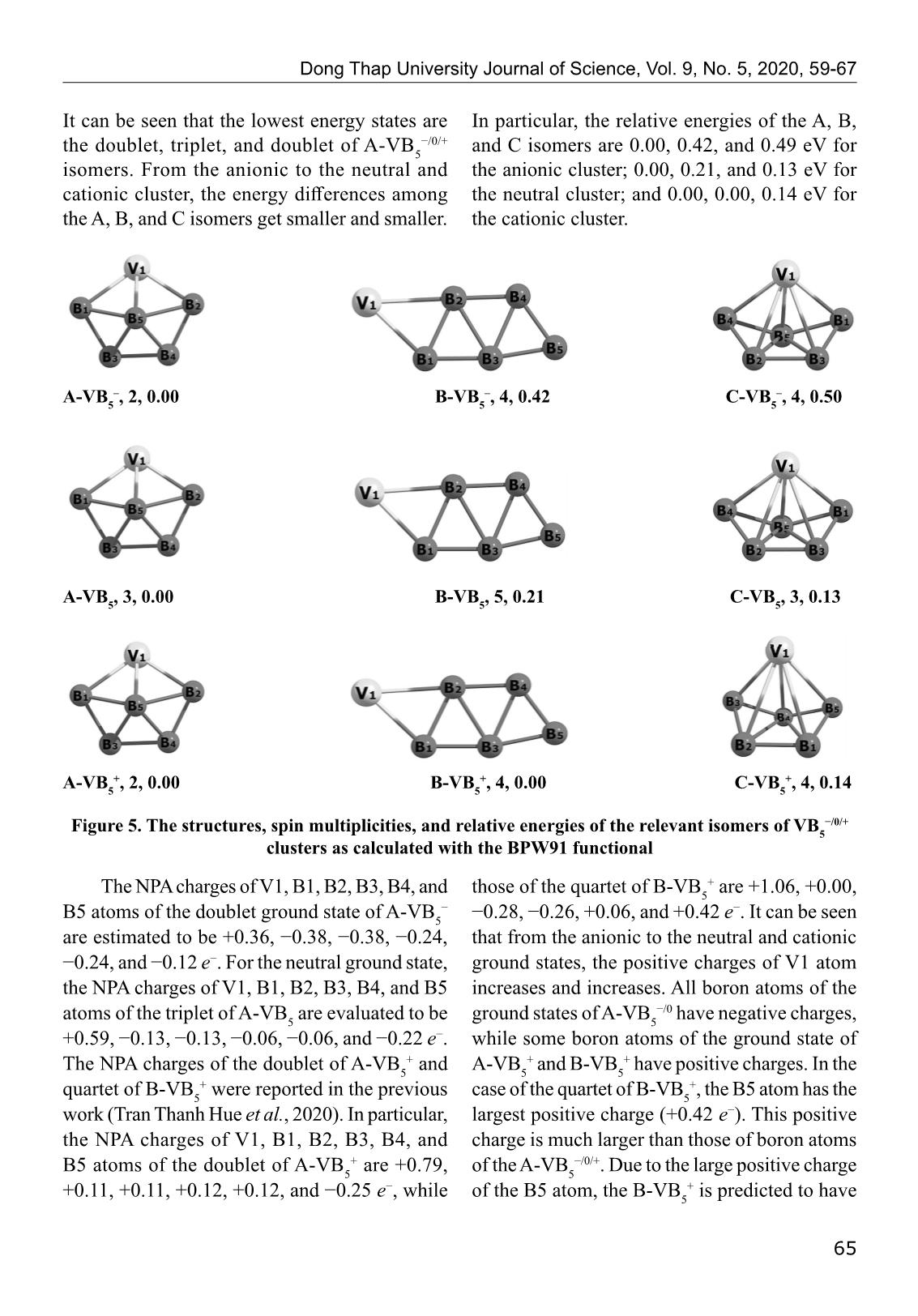
Trang 7
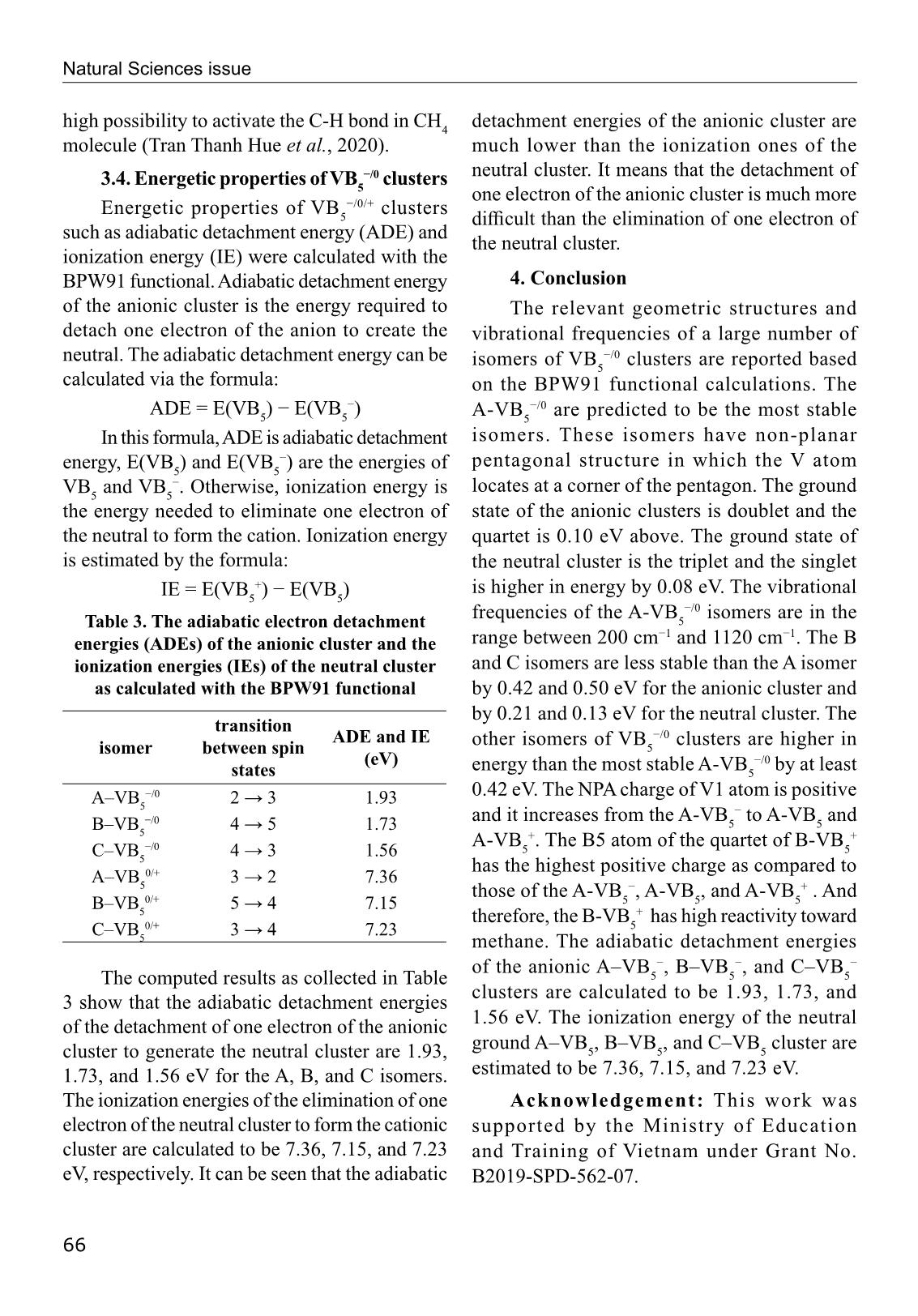
Trang 8
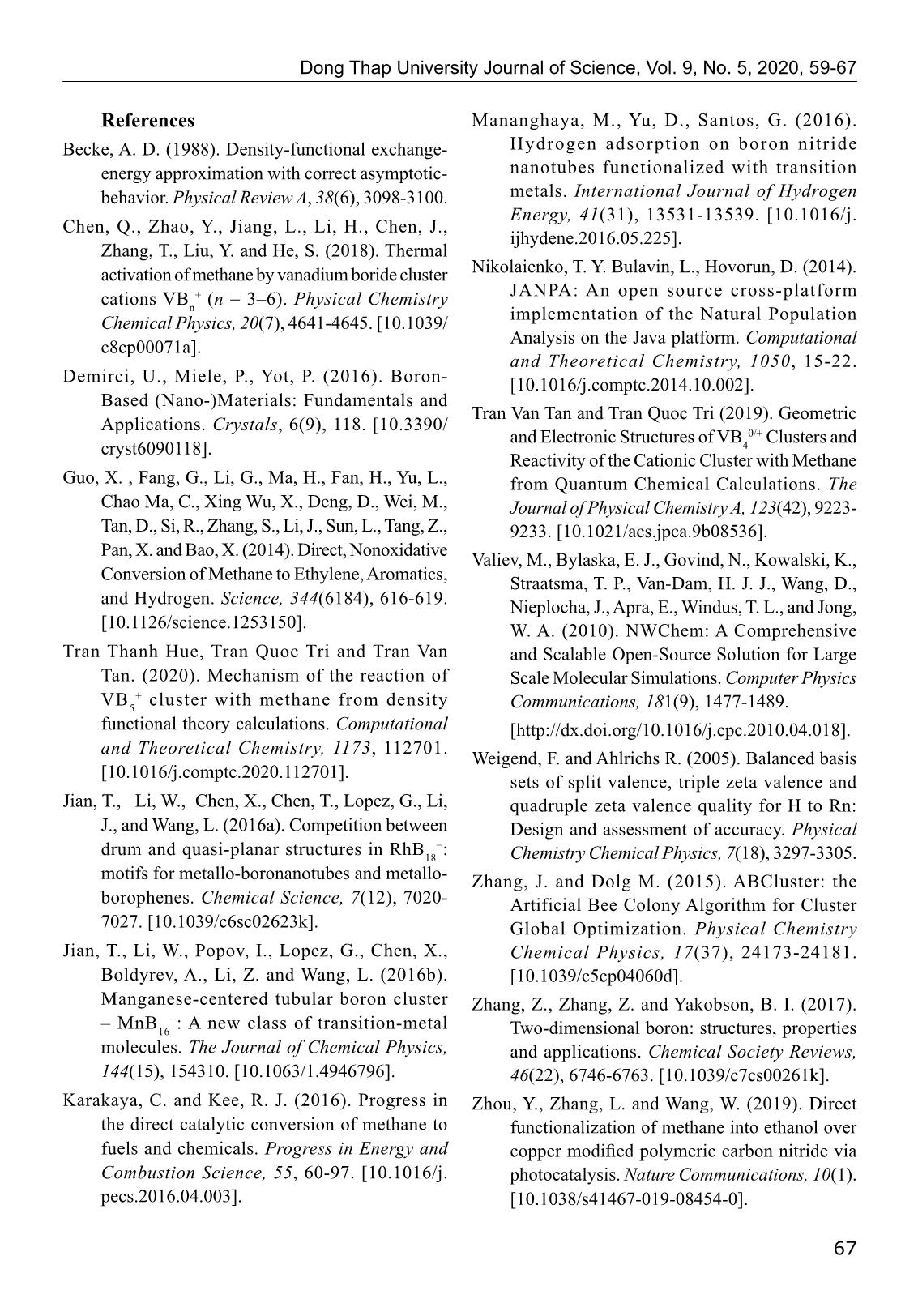
Trang 9
Tóm tắt nội dung tài liệu: Cấu trúc và tính chất của cluster VB₅⁻/⁰ tính bằng lý thuyết phiếm hàm mật độ
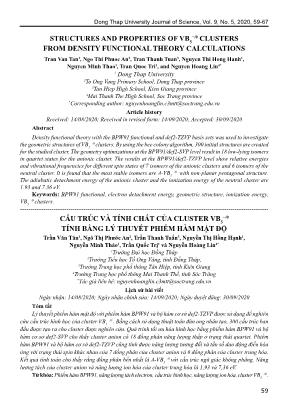
59 STRUCTURES AND PROPERTIES OF VB 5 −/0 CLUSTERS FROM DENSITY FUNCTIONAL THEORY CALCULATIONS Tran Van Tan1, Ngo Thi Phuoc An2, Tran Thanh Tuan3, Nguyen Thi Hong Hanh1, Nguyen Minh Thao1, Tran Quoc Tri1, and Nguyen Hoang Lin4* 1 Dong Thap University 2To Ong Vang Primary School, Dong Thap province 3Tan Hiep High School, Kien Giang province 4Mai Thanh The High School, Soc Trang province *Corresponding author: nguyenhoanglin.c3mtt@soctrang.edu.vn Article history Received: 14/08/2020; Received in revised form: 14/09/2020; Accepted: 30/09/2020 Abstract Density functional theory with the BPW91 functional and def2-TZVP basis sets was used to investigate the geometric structures of VB5 −/0 clusters. By using the bee colony algorithm, 300 initial structures are created for the studied cluster. The geometry optimizations at the BPW91/def2-SVP level result in 18 low-lying isomers in quartet states for the anionic cluster. The results at the BPW91/def2-TZVP level show relative energies and vibrational frequencies for diff erent spin states of 7 isomers of the anionic clusters and 6 isomers of the neutral cluster. It is found that the most stable isomers are A-VB5 −/0 with non-planar pentagonal structure. The adiabatic detachment energy of the anionic cluster and the ionization energy of the neutral cluster are 1.93 and 7.36 eV. Keywords: BPW91 functional, electron detachment energy, geometric structure, ionization energy, VB5 −/0 clusters. ---------------------------------------------------------------------------------------------------------------------- CẤU TRÚC VÀ TÍNH CHẤT CỦA CLUSTER VB 5 −/0 TÍNH BẰNG LÝ THUYẾT PHIẾM HÀM MẬT ĐỘ Trần Văn Tân1, Ngô Thị Phước An2, Trần Thanh Tuấn3, Nguyễn Thị Hồng Hạnh1, Nguyễn Minh Thảo1, Trần Quốc Trị1 và Nguyễn Hoàng Lin4* 1Trường Đại học Đồng Tháp 2Trường Tiểu học Tổ Ong Vàng, tỉnh Đồng Tháp, 3Trường Trung học phổ thông Tân Hiệp, tỉnh Kiên Giang 4Trường Trung học phổ thông Mai Thanh Thế, tỉnh Sóc Trăng *Tác giả liên hệ: nguyenhoanglin.c3mtt@soctrang.edu.vn Lịch sử bài viết Ngày nhận: 14/08/2020; Ngày nhận chỉnh sửa: 14/09/2020; Ngày duyệt đăng: 30/09/2020 Tóm tắt Lý thuyết phiếm hàm mật độ với phiếm hàm BPW91 và bộ hàm cơ sở def2-TZVP được sử dụng để nghiên cứu cấu trúc hình học của cluster VB5 −/0 . Bằng cách sử dụng thuật toán đàn ong nhân tạo, 300 cấu trúc ban đầu được tạo ra cho cluster được nghiên cứu. Quá trình tối ưu hóa hình học bằng phiếm hàm BPW91 và bộ hàm cơ sở def2-SVP cho thấy cluster anion có 18 đồng phân năng lượng thấp ở trạng thái quartet. Phiếm hàm BPW91 và bộ hàm cơ sở def2-TZVP cũng tính được năng lượng tương đối và tần số dao động điều hòa ứng với trạng thái spin khác nhau của 7 đồng phân của cluster anion và 6 đồng phân của cluster trung hòa. Kết quả tính toán cho thấy rằng đồng phân bền nhất là A-VB5 −/0 với cấu trúc ngũ giác không phẳng. Năng lượng tách của cluster anion và năng lượng ion hóa của cluster trung hòa là 1,93 và 7,36 eV. Từ khóa: Phiếm hàm BPW91, năng lượng tách electron, cấu trúc hình học, năng lượng ion hóa, cluster VB5 −/0 . Dong Thap University Journal of Science, Vol. 9, No. 5, 2020, 59-67 60 Natural Sciences issue 1. Introduction Clusters of transition metal with boron have been extensively investigated because of their potential application in catalysis and nanomaterial (Demirci, U. et al., 2016; Mananghaya, M. et al., 2016; Zhang, Z. et al., 2017). Several clusters of transition metals with boron such as MnB 16 − and RbB 18 − are highly stable and can be used as fundamental building-blocks for nanomaterial (Jian, T. et al., 2016a; Jian, T. et al., 2016b). On the other hand, methane has been known as an important resource which can be used to synthesize high value compounds (Guo, X. et al., 2014; Zhou, Y. et al., 2019). However, the σ C-H bond of methane is very stable with bond dissociation energy of 440 kJ/mol (Karakaya, C. and Kee R. J., 2016). Therefore, catalysts should be employed to activate the C-H bond of methane. In order to search for the effi cient catalysts, the reactivity of VB n + (n=3-6) clusters with methane were investigated by mass spectroscopy (Chen, Q. et al., 2018). From the mass spectra, the products of the reactions of VB 3 +, VB 4 +, VB 5 +, and VB6+ clusters with methane are determined to be VB 3 CH 2 + + H 2 and B 3 CH 3 + VH+; VB 4 CH 2 + + H 2 and B 4 CH 4 + V+; VB 5 CH 2 +; and VB 6 CH 2 + and VB 6 CH 4 (CH 2 ) n + (n = 0-2). Density functional theory with M06L and BPW91 functionals were applied to establish mechanisms for the reactions of VB 3 +, VB 4 +, and VB 5 + clusters with methane (Chen, Q. et al., 2018; Tran Thanh Hue et al., 2020; Tran Van Tan and Tran Quoc Tri, 2019). It was found that the formation of products is thermodynamically and kinetically favorable. These experimental and theoretical results provide new insight into the designation of new catalysts for methane activation. Although the structures of the cationic VB 5 + clusters and mechanism of this cluster with methane were studied, the geometric structures and energetic properties of the anionic and neutral VB 5 −/0 clusters have not been reported (Tran Thanh Hue et al., 2020). This study applied density functional theory to search for the low- lying isomers of VB 5 −/0 clusters. The BPW91 functional were employed for the studied system because this functional proves to be suffi cient to study the structures of VB 4 + and VB 5 + (Tran Thanh Hue et al., 2020; Tran Van Tan and Tran Quoc Tri, 2019). The geometries, spin states, vibrational frequencies and normal modes, relative energies, electron detachment energies of the anionic cluster, and ionization energies of the neutral cluster were calculated. The computational results gave a clear understanding of the geometrica ... B 5 − are positive and they are in the range from 200 to 1078 cm−1. It means that the optimized structure belongs to minimum on the potential energy surface. 764 1000 1027 1078 63 3.2. VB 5 The geometry optimization and vibrational frequency calculations for VB 5 were performed on the basis of the optimized geometries of isomers of VB 5 −. The results of the geometry optimization and vibrational frequency calculations for VB 5 cluster are presented in Figure 3 and Table 2. It can be seen that there are 6 important isomers of VB 5 . The relative energies of the lowest energy states of these isomers are in the range from 0.00 to 0.89 eV. The most stable isomer is determined to be A-VB 5 with a triplet ground state. The singlet and quintet of the same isomer are above the triplet ground state by 0.08 and 0.46 eV. The quintet of B-VB 5 , triplet of C-VB 5 , and quintet of D-VB 5 are higher in energy than the ground state by 0.21, 0.13, and 0.42 eV. The other isomers are less stable than the ground state by more than 0.71 eV. Figure 3. Geometries, spin multiplicities, and relative energies (eV) of the low-lying isomers of VB 5 cluster as computed with the BPW91 functional Table 2. The computed spin multiplicities (M), vibrational frequencies, and relative energies (RE) of the low-lying isomers of VB 5 clusters isomer M RE (eV) frequencies (cm–1) A–VB 5 3 0.00 227, 320, 401, 490, 581, 607, 675, 782, 790, 991, 1019, 1120 A–VB 5 1 0.08 232, 310, 412, 480, 584, 609, 686, 750, 793, 965, 1033, 1140 A–VB 5 5 0.46 146, 216, 331, 360, 443, 622, 659, 786, 904, 987, 1061, 1094 B–VB 5 5 0.21 127, 278, 289, 350, 393, 541, 589, 721, 816, 994, 1133, 1223 B–VB 5 3 0.50 127, 200, 300, 323, 396, 488, 636, 712, 806, 1002, 1152, 1199 B–VB 5 1 0.67 153, 318, 329, 357, 423, 497, 612, 736, 817, 983, 1107, 1212 C–VB 5 3 0.13 309, 337, 378, 435, 500, 581, 621, 728, 825, 920, 1102, 1141 C–VB 5 1 0.39 198, 269, 367, 417, 511, 521, 638, 731, 823, 953, 1063, 1112 C–VB 5 5 0.51 143, 298, 342, 416, 478, 516, 600, 739, 900, 927, 1086, 1150 D–VB 5 5 0.42 172, 204, 242, 347, 404, 572, 610, 695, 917, 945, 1067, 1271 A–VB 5 , 3, 0.00 B–VB 5 , 5, 0.21 C–VB 5 , 3, 0.13 D–VB 5 , 5, 0.42 E–VB 5 , 3, 0.71 F–VB 5 , 3, 0.89 Dong Thap University Journal of Science, Vol. 9, No. 5, 2020, 59-67 64 Natural Sciences issue D–VB 5 3 0.67 146, 195, 214, 321, 415, 594, 615, 703, 909, 967, 1080, 1265 D–VB 5 1 0.93 215, 227, 268, 376, 421, 594, 630, 713, 856, 967, 1080, 1253 E–VB 5 3 0.71 284, 298, 497, 514, 601, 603, 653, 745, 756, 884, 886, 991 F–VB 5 3 0.89 201, 229, 296, 321, 342, 509, 634, 699, 748, 1076, 1151, 1272 F–VB 5 5 1.07 95, 194, 229, 322, 332, 534, 608, 637, 714, 984, 1104, 1283 F–VB 5 1 1.11 211, 236, 276, 311, 335, 508, 625, 698, 746, 1082, 1150, 1266 Figure 4. The vibrational frequencies (cm−1) and normal modes of the triplet states of A-VB 5 as computed with the BPW91 and def2-TZVP basis set The vibrational frequencies of the relevant isomers of the VB 5 cluster are presented in Table 2. It can be seen that all the frequencies are positive. The smallest frequency is around 100 cm−1, while the largest frequency is around 1300 cm−1. The vibrational normal modes of the neutral triplet ground state are displayed in Figure 4. The normal modes with frequencies of 226, 401, 580, 675, 790, 990, and 1119 cm−1 are symmetric modes, while the others are antisymmetric modes. 227 320 401 490 581 607 675 782 790 991 1019 1120 3.3. Structures and NPA charges of VB 5 −/0/+ clusters In order to understand the structural variations of the anionic, neutral, and cationic clusters, the important isomers of VB 5 −/0/+ clusters were collected and presented in Figure 5. It should be noted that the computational results of the anionic and neutral are obtained in this work, while those of the cationic cluster is discussed in the previous work (Tran Thanh Hue et al., 2020). 65 It can be seen that the lowest energy states are the doublet, triplet, and doublet of A-VB 5 −/0/+ isomers. From the anionic to the neutral and cationic cluster, the energy diff erences among the A, B, and C isomers get smaller and smaller. In particular, the relative energies of the A, B, and C isomers are 0.00, 0.42, and 0.49 eV for the anionic cluster; 0.00, 0.21, and 0.13 eV for the neutral cluster; and 0.00, 0.00, 0.14 eV for the cationic cluster. Figure 5. The structures, spin multiplicities, and relative energies of the relevant isomers of VB 5 −/0/+ clusters as calculated with the BPW91 functional A-VB 5 –, 2, 0.00 B-VB 5 –, 4, 0.42 C-VB 5 –, 4, 0.50 A-VB 5 , 3, 0.00 B-VB 5 , 5, 0.21 C-VB 5 , 3, 0.13 A-VB 5 +, 2, 0.00 B-VB 5 +, 4, 0.00 C-VB 5 +, 4, 0.14 The NPA charges of V1, B1, B2, B3, B4, and B5 atoms of the doublet ground state of A-VB 5 − are estimated to be +0.36, −0.38, −0.38, −0.24, −0.24, and −0.12 e−. For the neutral ground state, the NPA charges of V1, B1, B2, B3, B4, and B5 atoms of the triplet of A-VB 5 are evaluated to be +0.59, −0.13, −0.13, −0.06, −0.06, and −0.22 e−. The NPA charges of the doublet of A-VB 5 + and quartet of B-VB 5 + were reported in the previous work (Tran Thanh Hue et al., 2020). In particular, the NPA charges of V1, B1, B2, B3, B4, and B5 atoms of the doublet of A-VB 5 + are +0.79, +0.11, +0.11, +0.12, +0.12, and −0.25 e−, while those of the quartet of B-VB 5 + are +1.06, +0.00, −0.28, −0.26, +0.06, and +0.42 e−. It can be seen that from the anionic to the neutral and cationic ground states, the positive charges of V1 atom increases and increases. All boron atoms of the ground states of A-VB 5 −/0 have negative charges, while some boron atoms of the ground state of A-VB 5 + and B-VB 5 + have positive charges. In the case of the quartet of B-VB 5 +, the B5 atom has the largest positive charge (+0.42 e−). This positive charge is much larger than those of boron atoms of the A-VB 5 −/0/+. Due to the large positive charge of the B5 atom, the B-VB 5 + is predicted to have Dong Thap University Journal of Science, Vol. 9, No. 5, 2020, 59-67 66 Natural Sciences issue high possibility to activate the C-H bond in CH 4 molecule (Tran Thanh Hue et al., 2020). 3.4. Energetic properties of VB 5 −/0 clusters Energetic properties of VB 5 −/0/+ clusters such as adiabatic detachment energy (ADE) and ionization energy (IE) were calculated with the BPW91 functional. Adiabatic detachment energy of the anionic cluster is the energy required to detach one electron of the anion to create the neutral. The adiabatic detachment energy can be calculated via the formula: ADE = E(VB 5 ) − E(VB 5 −) In this formula, ADE is adiabatic detachment energy, E(VB 5 ) and E(VB 5 −) are the energies of VB 5 and VB 5 −. Otherwise, ionization energy is the energy needed to eliminate one electron of the neutral to form the cation. Ionization energy is estimated by the formula: IE = E(VB 5 +) − E(VB 5 ) Table 3. The adiabatic electron detachment energies (ADEs) of the anionic cluster and the ionization energies (IEs) of the neutral cluster as calculated with the BPW91 functional isomer transition between spin states ADE and IE (eV) A–VB 5 −/0 2 → 3 1.93 B–VB 5 −/0 4 → 5 1.73 C–VB 5 −/0 4 → 3 1.56 A–VB 5 0/+ 3 → 2 7.36 B–VB 5 0/+ 5 → 4 7.15 C–VB 5 0/+ 3 → 4 7.23 The computed results as collected in Table 3 show that the adiabatic detachment energies of the detachment of one electron of the anionic cluster to generate the neutral cluster are 1.93, 1.73, and 1.56 eV for the A, B, and C isomers. The ionization energies of the elimination of one electron of the neutral cluster to form the cationic cluster are calculated to be 7.36, 7.15, and 7.23 eV, respectively. It can be seen that the adiabatic detachment energies of the anionic cluster are much lower than the ionization ones of the neutral cluster. It means that the detachment of one electron of the anionic cluster is much more diffi cult than the elimination of one electron of the neutral cluster. 4. Conclusion The relevant geometric structures and vibrational frequencies of a large number of isomers of VB 5 −/0 clusters are reported based on the BPW91 functional calculations. The A-VB 5 −/0 are predicted to be the most stable isomers. These isomers have non-planar pentagonal structure in which the V atom locates at a corner of the pentagon. The ground state of the anionic clusters is doublet and the quartet is 0.10 eV above. The ground state of the neutral cluster is the triplet and the singlet is higher in energy by 0.08 eV. The vibrational frequencies of the A-VB 5 −/0 isomers are in the range between 200 cm−1 and 1120 cm−1. The B and C isomers are less stable than the A isomer by 0.42 and 0.50 eV for the anionic cluster and by 0.21 and 0.13 eV for the neutral cluster. The other isomers of VB 5 −/0 clusters are higher in energy than the most stable A-VB 5 −/0 by at least 0.42 eV. The NPA charge of V1 atom is positive and it increases from the A-VB 5 − to A-VB 5 and A-VB 5 +. The B5 atom of the quartet of B-VB 5 + has the highest positive charge as compared to those of the A-VB 5 −, A-VB 5 , and A-VB 5 + . And therefore, the B-VB 5 + has high reactivity toward methane. The adiabatic detachment energies of the anionic A–VB 5 −, B–VB 5 −, and C–VB 5 − clusters are calculated to be 1.93, 1.73, and 1.56 eV. The ionization energy of the neutral ground A–VB 5 , B–VB 5 , and C–VB 5 cluster are estimated to be 7.36, 7.15, and 7.23 eV. Acknowledgement: This work was supported by the Ministry of Education and Training of Vietnam under Grant No. B2019-SPD-562-07. 67 References Becke, A. D. (1988). Density-functional exchange- energy approximation with correct asymptotic- behavior. Physical Review A, 38(6), 3098-3100. Chen, Q., Zhao, Y., Jiang, L., Li, H., Chen, J., Zhang, T., Liu, Y. and He, S. (2018). Thermal activation of methane by vanadium boride cluster cations VB n + (n = 3–6). Physical Chemistry Chemical Physics, 20(7), 4641-4645. [10.1039/ c8cp00071a]. Demirci, U., Miele, P., Yot, P. (2016). Boron- Based (Nano-)Materials: Fundamentals and Applications. Crystals, 6(9), 118. [10.3390/ cryst6090118]. Guo, X. , Fang, G., Li, G., Ma, H., Fan, H., Yu, L., Chao Ma, C., Xing Wu, X., Deng, D., Wei, M., Tan, D., Si, R., Zhang, S., Li, J., Sun, L., Tang, Z., Pan, X. and Bao, X. (2014). Direct, Nonoxidative Conversion of Methane to Ethylene, Aromatics, and Hydrogen. Science, 344(6184), 616-619. [10.1126/science.1253150]. Tran Thanh Hue, Tran Quoc Tri and Tran Van Tan. (2020). Mechanism of the reaction of VB 5 + cluster with methane from density functional theory calculations. Computational and Theoretical Chemistry, 1173, 112701. [10.1016/j.comptc.2020.112701]. Jian, T., Li, W., Chen, X., Chen, T., Lopez, G., Li, J., and Wang, L. (2016a). Competition between drum and quasi-planar structures in RhB 18 −: motifs for metallo-boronanotubes and metallo- borophenes. Chemical Science, 7(12), 7020- 7027. [10.1039/c6sc02623k]. Jian, T., Li, W., Popov, I., Lopez, G., Chen, X., Boldyrev, A., Li, Z. and Wang, L. (2016b). Manganese-centered tubular boron cluster – MnB 16 −: A new class of transition-metal molecules. The Journal of Chemical Physics, 144(15), 154310. [10.1063/1.4946796]. Karakaya, C. and Kee, R. J. (2016). Progress in the direct catalytic conversion of methane to fuels and chemicals. Progress in Energy and Combustion Science, 55, 60-97. [10.1016/j. pecs.2016.04.003]. Mananghaya, M., Yu, D., Santos, G. (2016). Hydrogen adsorption on boron nitr ide nanotubes functionalized with transition metals. International Journal of Hydrogen Energy, 41(31), 13531-13539. [10.1016/j. ijhydene.2016.05.225]. Nikolaienko, T. Y. Bulavin, L., Hovorun, D. (2014). JANPA: An open source cross-platform implementation of the Natural Population Analysis on the Java platform. Computational and Theoretical Chemistry, 1050, 15-22. [10.1016/j.comptc.2014.10.002]. Tran Van Tan and Tran Quoc Tri (2019). Geometric and Electronic Structures of VB 4 0/+ Clusters and Reactivity of the Cationic Cluster with Methane from Quantum Chemical Calculations. The Journal of Physical Chemistry A, 123(42), 9223- 9233. [10.1021/acs.jpca.9b08536]. Valiev, M., Bylaska, E. J., Govind, N., Kowalski, K., Straatsma, T. P., Van-Dam, H. J. J., Wang, D., Nieplocha, J., Apra, E., Windus, T. L., and Jong, W. A. (2010). NWChem: A Comprehensive and Scalable Open-Source Solution for Large Scale Molecular Simulations. Computer Physics Communications, 181(9), 1477-1489. []. Weigend, F. and Ahlrichs R. (2005). Balanced basis sets of split valence, triple zeta valence and quadruple zeta valence quality for H to Rn: Design and assessment of accuracy. Physical Chemistry Chemical Physics, 7(18), 3297-3305. Zhang, J. and Dolg M. (2015). ABCluster: the Artificial Bee Colony Algorithm for Cluster Global Optimization. Physical Chemistry Chemical Physics, 17(37), 24173-24181. [10.1039/c5cp04060d]. Zhang, Z., Zhang, Z. and Yakobson, B. I. (2017). Two-dimensional boron: structures, properties and applications. Chemical Society Reviews, 46(22), 6746-6763. [10.1039/c7cs00261k]. Zhou, Y., Zhang, L. and Wang, W. (2019). Direct functionalization of methane into ethanol over copper modifi ed polymeric carbon nitride via photocatalysis. Nature Communications, 10(1). [10.1038/s41467-019-08454-0]. Dong Thap University Journal of Science, Vol. 9, No. 5, 2020, 59-67
File đính kèm:
 cau_truc_va_tinh_chat_cua_cluster_vb_tinh_bang_ly_thuyet_phi.pdf
cau_truc_va_tinh_chat_cua_cluster_vb_tinh_bang_ly_thuyet_phi.pdf

